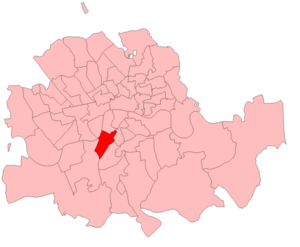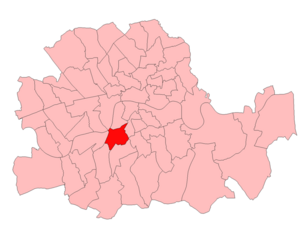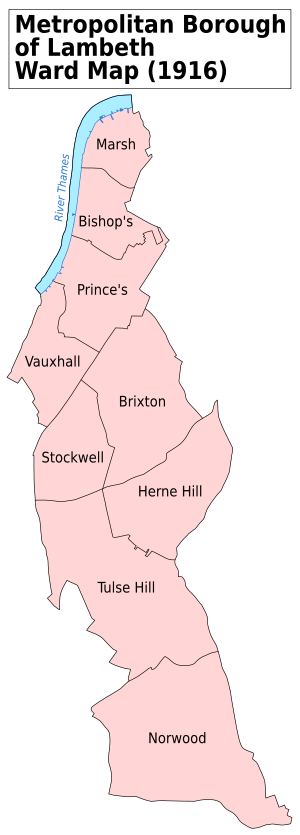Kennington (UK Parliament constituency) facts for kids
Quick facts for kids {{{Name}}}[[{{{Type}}} constituency]] |
|
|---|---|
| [[Image:{{{Map1}}}Constituency.svg|120px|]] [[Image:England{{{Map2}}}.svg|120px|]] |
|
| {{{Name}}} shown within [[{{{Entity}}}]], and {{{Entity}}} shown within England | |
| Created: | {{{Year}}} |
| MP: | {{{MP}}} |
| Party: | {{{Party}}} |
| Type: | House of Commons |
| County: | [[{{{County}}}]] |
| EP constituency: | [[{{{EP}}} (European Parliament constituency)|{{{EP}}}]] |
Kennington was a special area in South London that used to elect its own representative to the UK government. This area was called a borough constituency. A constituency is like a voting district, and the person elected from it is called a Member of Parliament (MP). This MP would go to the House of Commons to speak for the people of Kennington.
The Kennington constituency was created for the general election in 1885. It stopped being a separate constituency in 1950.
In 1918, a woman named Alice Theresa Lucas made history here. She was the first woman to run as a candidate for the Conservative Party. Even though she didn't win, she got a lot of votes (32.2%) and came in second place. If she had won, she would have been the very first woman MP!
Who Represented Kennington?
Over the years, many different people were elected to represent Kennington in Parliament. These Members of Parliament (MPs) worked to bring the concerns of the Kennington community to the government.
| Election | Member | Party | |
|---|---|---|---|
| 1885 | Robert Gent-Davis | Conservative | |
| 1889 | Mark Hanbury Beaufoy | Liberal | |
| 1895 | Sir Frederick Cook | Conservative | |
| 1906 | Sir Stephen Collins | Liberal | |
| 1918 | Henry Purchase | Coalition Liberal | |
| 1922 | Francis Capel Harrison | Conservative | |
| 1923 | Thomas Williams | Labour | |
| 1924 | George Harvey | Unionist | |
| 1929 | Leonard Matters | Labour | |
| 1931 | Sir George Harvey | Conservative | |
| 1939 | John Wilmot | Labour | |
| 1945 | Charles Gibson | Labour | |
| 1950 | constituency abolished | ||
Election Highlights
The Kennington constituency saw many elections during its time. Voters would choose their MP in a "general election," which usually happens every few years across the whole country. Sometimes, if an MP left their job early, a "by-election" would be held just for that constituency.
Over the years, the Kennington seat was won by different political parties. In the early days, it was often a close contest between the Conservative and Liberal parties. As time went on, especially after World War I, the Labour Party became a strong contender and eventually won the seat multiple times.
The last MP for Kennington was Charles Gibson, from the Labour Party, who was elected in 1945. When the constituency was abolished in 1950, the area was divided into new constituencies like Vauxhall and Brixton.
Images for kids









